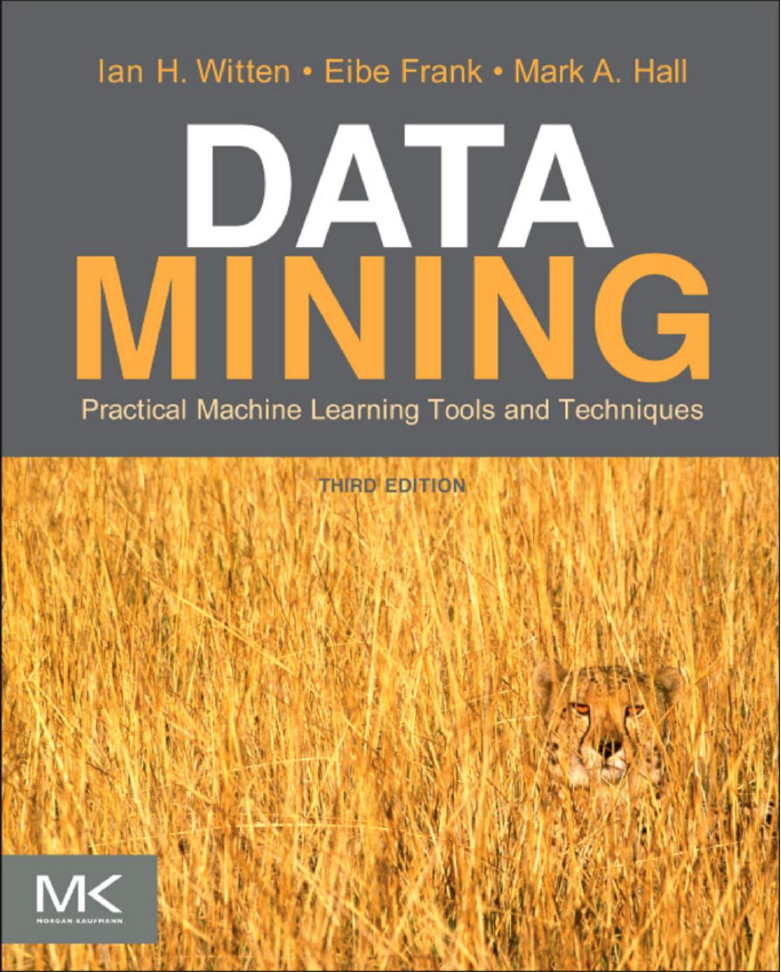Front cover
Data Mining: Practical Machine Learning Tools and Techniques
Copyright page
Table of contents
List of Figures
List of Tables
Preface
Updated and revised content
Acknowledgments
About the Authors
PART I: Introduction to Data Mining
Chapter 1: What’s It All About?
Data mining and machine learning
Simple examples: the weather and other problems
Fielded applications
Machine learning and statistics
Generalization as search
Data mining and ethics
Further reading
Chapter 2: Input: Concepts, Instances, and Attributes
What’s a concept?
What’s in an example?
What’s in an attribute?
Preparing the input
Further reading
Chapter 3: Output: Knowledge Representation
Tables
Linear models
Trees
Rules
Instance-based representation
Clusters
Further reading
Chapter 4: Algorithms: The Basic Methods
InFerring rudimentary rules
Statistical modeling
Divide-and-conquer: constructing decision trees
Covering algorithms: constructing rules
Mining association rules
Linear models
Instance-based learning
Clustering
Multi-instance learning
Further reading
Weka implementations
Chapter 5: Credibility: Evaluating What’s Been Learned
Training and testing
Predicting performance
Cross-validation
Other estimates
Comparing data mining schemes
Predicting probabilities
Counting the cost
Evaluating numeric prediction
Minimum description length principle
Applying the MDL principle to clustering
Further reading
Part 2: Advanced Data Mining
Chapter 6: Implementations: Real Machine Learning Schemes
Decision trees
Classification rules
Association rules
Extending linear models
Instance-based learning
Numeric prediction with local linear models
Bayesian networks
Clustering
Semisupervised learning
Multi-instance learning
Weka implementations
Chapter 7: Data Transformations
Attribute selection
Discretizing numeric attributes
Projections
Sampling
Cleansing
Transforming multiple classes to binary ones
Calibrating class probabilities
Further reading
Weka implementations
Chapter 8: Ensemble Learning
Combining multiple models
Bagging
Randomization
Boosting
Additive regression
Interpretable ensembles
Stacking
Further reading
Weka implementations
Chapter 9: Moving on: Applications and Beyond
Applying data mining
Learning from massive datasets
Data stream learning
Incorporating domain knowledge
Text mining
Web mining
Adversarial situations
Ubiquitous data mining
Further reading
PART III: The Weka Data Mining Workbench
Chapter 10: Introduction to Weka
What’s in weka?
How do you use it?
What else can you do?
How do you get it?
Chapter 11: The Explorer
Getting started
Exploring the explorer
Filtering algorithms
Learning algorithms
Metalearning algorithms
Clustering algorithms
Association-rule learners
Attribute selection
Chapter 12: The Knowledge Flow Interface
Getting started
Components
Configuring and connecting the components
Incremental learning
Chapter 13: The Experimenter
Getting started
Simple setup
Advanced setup
The analyze panel
Distributing processing over several machines
Chapter 14: The Command-Line Interface
Getting started
The structure of weka
Command-line options
Chapter 15: Embedded Machine Learning
A simple data mining application
Chapter 16: Writing New Learning Schemes
An example classifier
Conventions for implementing classifiers
Chapter 17: Tutorial Exercises for the Weka Explorer
Introduction to the explorer interface
Nearest-neighbor learning and decision trees
Classification boundaries
Preprocessing and parameter tuning
Document classification
Mining association rules
References
Index
















 2023年江西萍乡中考道德与法治真题及答案.doc
2023年江西萍乡中考道德与法治真题及答案.doc 2012年重庆南川中考生物真题及答案.doc
2012年重庆南川中考生物真题及答案.doc 2013年江西师范大学地理学综合及文艺理论基础考研真题.doc
2013年江西师范大学地理学综合及文艺理论基础考研真题.doc 2020年四川甘孜小升初语文真题及答案I卷.doc
2020年四川甘孜小升初语文真题及答案I卷.doc 2020年注册岩土工程师专业基础考试真题及答案.doc
2020年注册岩土工程师专业基础考试真题及答案.doc 2023-2024学年福建省厦门市九年级上学期数学月考试题及答案.doc
2023-2024学年福建省厦门市九年级上学期数学月考试题及答案.doc 2021-2022学年辽宁省沈阳市大东区九年级上学期语文期末试题及答案.doc
2021-2022学年辽宁省沈阳市大东区九年级上学期语文期末试题及答案.doc 2022-2023学年北京东城区初三第一学期物理期末试卷及答案.doc
2022-2023学年北京东城区初三第一学期物理期末试卷及答案.doc 2018上半年江西教师资格初中地理学科知识与教学能力真题及答案.doc
2018上半年江西教师资格初中地理学科知识与教学能力真题及答案.doc 2012年河北国家公务员申论考试真题及答案-省级.doc
2012年河北国家公务员申论考试真题及答案-省级.doc 2020-2021学年江苏省扬州市江都区邵樊片九年级上学期数学第一次质量检测试题及答案.doc
2020-2021学年江苏省扬州市江都区邵樊片九年级上学期数学第一次质量检测试题及答案.doc 2022下半年黑龙江教师资格证中学综合素质真题及答案.doc
2022下半年黑龙江教师资格证中学综合素质真题及答案.doc